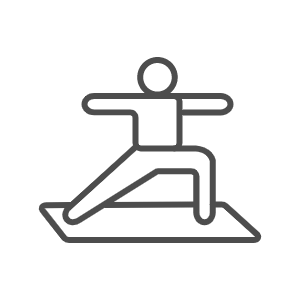
NEW In!
PURE-Matte Light TaupeShopping cart
Your shopping basket is empty
Yoga

Meditation
Sets & Bundles

The first rays of sunshine are appearing, spring is slowly arriving - for many just the right time for a little "spring detox". A detox cure does not necessarily have to consist of freshly squeezed juices, smoothies or expensive detox shakes and detox teas, on the contrary: Today we would like to show you how you can use yoga and its sister science, Ayurveda, to protect your body can relieve - easily at home and without expensive fasting cure. Ready?
Opinions are already divided on this question - while some swear by therapeutic fasting and the great detoxification, others are convinced that the liver and kidneys do their job well without fasting and therefore special detox measures are not necessary.
I see it this way: our body is a small miracle and it's really impressive how it works. Still, I know how many times I've resorted to processed foods, refined sugars, and unhealthy snacking this past winter - more often than I'd like, to be honest.
That's why I always have a little detox in spring that doesn't stick to a classic fasting cure. In this way I can support my body without any pressure or stress, boost my metabolism, bring everything back into balance and feel fitter, more alert and energetic without having to make major sacrifices, but with lots of yoga and Ayurveda.
In yoga, as in Ayurveda, there are many ways to initiate detoxification. Some of them are:
We'll take a closer look at the different cleansing techniques below, but first I want to point out one thing: listen to your body and your intuition when putting together your own personal detox. Not all detox techniques are right for everyone or easy to do at home.
If you are unsure, please speak to your doctor or naturopath.
Pranayama is part of the daily routine for many yogis - and that's perfect! If you want to focus on detoxification, we recommend trying the following exercises:
Full yogic breathing is primarily about deep breathing. Far too often we breathe relatively shallowly or even irregularly in everyday life, while deep breathing is essential for stress regulation.
To begin the exercise, sit comfortably and upright on a meditation cushion or chair. Consciously breathe in and out a few times and then begin to fill your lungs completely. To do this, first breathe deeply into your stomach, then fill your chest and breathe up to your collarbones before, after a short breathing pause, let all the air flow out again from your collarbones to your stomach. Repeat the exercise a few times.
We have already published an entire blog post about Kapala Bhati - we love the exercise so much. It not only gives you new energy, but also cleanses your lungs and stimulates your metabolism, making it the perfect detox companion. You can read about how the exercise works here .
In addition to certain breathing exercises, certain asanas can also be used to promote purification and support the body in its detoxification processes. As you may know, each asana has its own unique effect and can contribute to your well-being in a very individual way.
Classic detox asanas are those that either aid digestion, support the liver, or boost metabolism. So you can't go wrong with rotating movements, exercises in the prone position and the position of the child.
Here we have put together a small detox flow for you. Warm up with some sun salutations beforehand.

In the cobra, the abdominal organs receive gentle pressure, which stimulates digestion and metabolism. The cobra is therefore ideally suited for a slow start into the detox flow.

With the boat we go into another backbend, the slight pressure on the abdominal organs is now a gentle massage. You can either hold the exercise or do it dynamically, i.e. rocking a little. Both are fine, but the dynamic version increases the massage effect even more.

After the two backbends, we switch to the child's pose - not only for detox reasons, but also because the child's pose is a great counterpoint to the backbends. The spine becomes long and can relax.
Hold the position as long as it feels good to you.

Twisted poses are the classic among detox asanas. For our flow, we have opted for the swivel seat. Here both the liver and the digestion are optimally stimulated. Build the exercise first to the right and then to the left.
Finally, you can relax in Savasana - because deceleration and stress reduction are also an essential part of successful detoxification!
You can fill whole books about Ayurveda and type-appropriate nutrition and maybe we will write one or the other blog post about it - do you want to?
For our detox we adhere to the basic Ayurvedic principles:
A detox classic from Ayurveda is Kitchari. For this, mung beans (peeled and halved) are simply cooked with rice and vegetables and spices.
Kitchari is easy to digest - so it relieves stress and at the same time provides your body with all the important nutrients. Plus it's really tasty :)
Of course, a detox article also includes the “right” cleaning procedures. One thing in advance: Some of them are not necessarily pleasant - so before you experiment with them, please read them carefully and, if in doubt, ask your doctor or naturopath.
In yoga, the six kriyas are often spoken of in connection with purification. These are:
Similar to the Yoga Kriyas, Ayurveda has the so-called Panchakarma cure, with Panchakarma standing for five different cleaning techniques.
A Panchakarma cure usually lasts three to four weeks and consists of a cleansing phase and a build-up phase. However, the cure is not without its problems and should therefore not be carried out without medical supervision - so it is best to get support from an Ayurveda doctor.
How you carry out your detox at the end is of course up to you. In any case, stay alert and listen to your body.

You already know that yoga and breathing are inseparable and have a lot of health benefits - in our blog post on pranayama we have already introdu...
Continue reading
In our fast-moving world, we are constantly busy: we plan, analyze and are usually somewhere else mentally. For many, this is the only rhythm they...
Continue reading